As Scott and I were unloading our luggage into the hotel room in Albuquerque, I mentioned that I thought all the changes in atmospheres and altitudes from our whirlwind week in the Great Plains and Southwest were playing tricks on my sinuses. I felt fine apart from a little runny nose and didn’t think twice about hitting an Albuquerque Isotopes game on a hot, dry New Mexico Sunday night.
By Monday morning, my sinuses were gushing, my throat was raw from the drainage and the pressure in my head was light but insistent. I figured it was just a head cold, rare in the summer, but just another minor challenge to overcome on this trip. We went out for lunch and set off on the long, long road to Phoenix.
The next day, I got the news that threatened to derail my journey more than any rainout: I had COVID.
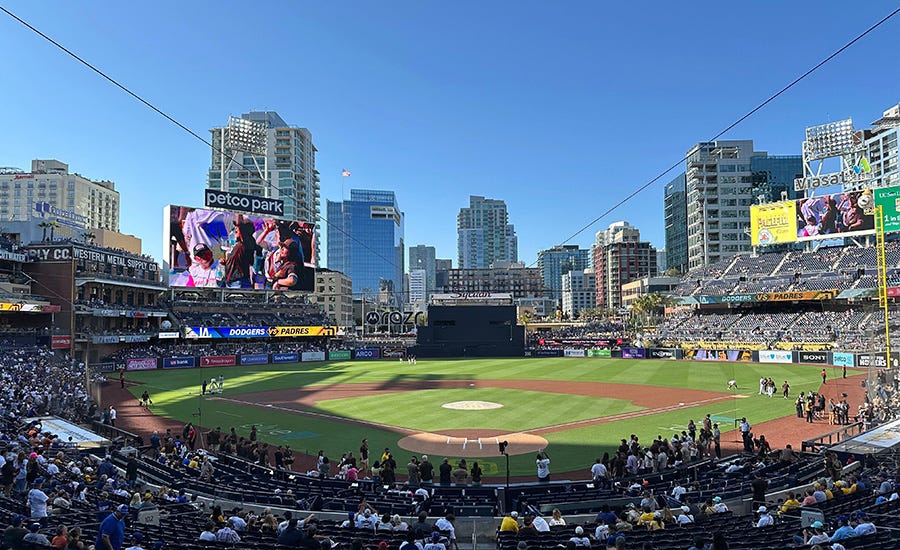
Let’s back up a second.
When plotting the route, I gave us three days to drive from Houston to Phoenix. Our meandering path from Minute Maid Park to Midland to Albuquerque and finally to the Valley of the Sun added a couple of hours and about 150 miles versus the more direct southern route, but afforded us a chance to take in a couple minor league games and see some sights.
Ratliff Stadium, Odessa, Texas: Home to the Odessa Permian Panthers, as popularized by the book and film Friday Night Lights, as well as the cross-town Odessa High Bronchos. Unfortunately, the stadium is completely fenced off when not in use, ostensibly to keep those little punks from rival Midland from coming over and doing donuts on the field in their F-350s.
Aliens, Roswell, New Mexico: The 1947 crash of a Project Mogul nuclear weapon test detection balloon has spurred extraterrestrial conspiracy theories for more than 75 years. The city has leaned in hard on UFO mythology, adorning every corner of town with sculptures of otherworldly beings and spacecraft. Even the McDonald’s on the main drag is shaped like a flying saucer. If you must know the truth, aliens have visited Earth and they live among us now, unrecognizable to the eye. It’s our human pride and limited imagination that assumes any beings from outer space must have a head, neck, torso, two arms and two legs.
Western Railroads, Vaughn, New Mexico: The town of Vaughn sits at an intersection of the BNSF and Union Pacific railroads, and served as a switching hub in the early-to-mid 1900s. The old depot building from 1908 still exists, but the town is little more than a gas stop for car and truck traffic and a reminder of the heavy infrastructure that facilitated coast-to-coast manifest destiny.
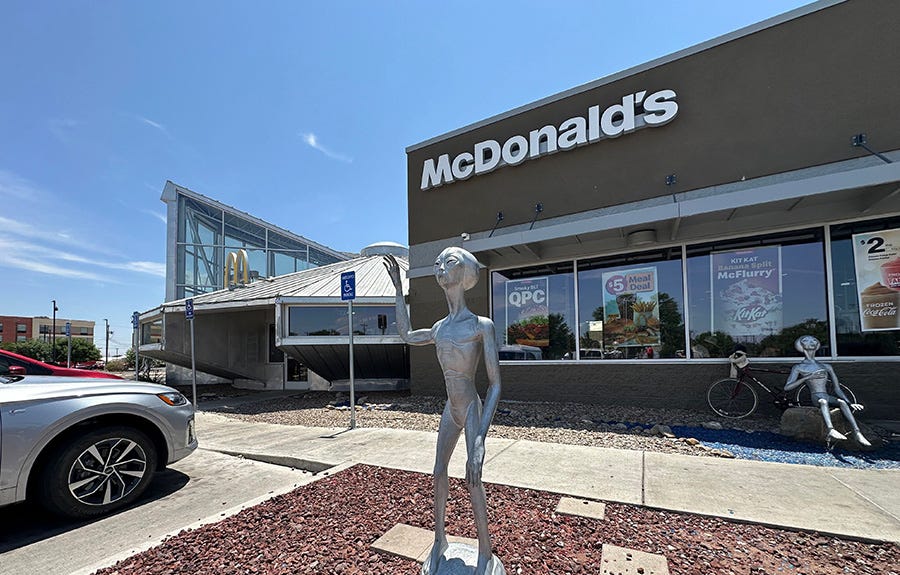
Scott had mentioned taking in an Albuquerque Isotopes game relatively early on in the planning process of our three week leg together, an idea I wholeheartedly embraced. I had been to Albuquerque once before, in 2008, with the city being the turnaround point for the longest tour we ever did.1 New Mexico in November is sunny, but chilly: the place where we stayed had a wood stove that supplied heat for the frigid mountain night. New Mexico in July is a different story, though the high temperature in the 90s was at least balanced by relatively low humidity in the thin, high altitude air.
In 2003, the Calgary Cannons minor league baseball team moved to Albuquerque and renamed themselves the Isotopes in reference to “Hungry, Hungry Homer,” a 12th season episode of the Simpsons in which the hometown baseball club concealed a plot to move to New Mexico, prompting Homer to engage in a hunger strike to reveal the truth.2 Fittingly, the Isotopes’ home ballpark features life-size statues of Homer, Marge, Bart and Lisa Simpson throughout the concourse.
Despite being a minor league facility, Isotopes Park was really impressive all around, from the picturesque mountain backdrop beyond the outfield walls to the superb food and beverage options available. While it required a short hike out to the sunny right field corner, the ballpark’s craft beer bar featured roughly three dozen taps of local and regional brews running the gamut of styles, a more bountiful collection of beer than in any major league stadium I’ve visited so far.3 They also offered a pint of “mystery beer” for $7.50: the bartender wasn’t told what it was, could show you the color but not taste or smell it, and you’re not allowed to taste or smell it either until you buy it. I bought it. Pretty sure it was Sierra Nevada Pale Ale, or something local that bares a striking resemblance. Great deal, regardless. I also got a small helmet full of red chile braised ribs, and I really only want to eat meals out of headwear from now on.
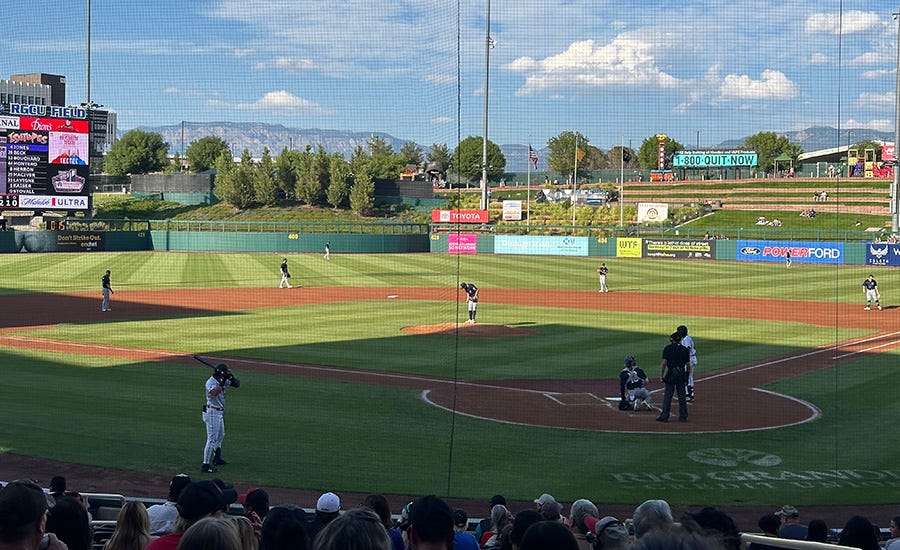
Like their parent club, the Colorado Rockies, the ‘Topes play at nearly a mile above sea level, leading to a burst of offense from both clubs as batted balls travel further in the rarified air. The plucky, cellar-dwelling Isotopes blasted six home runs into the dusky New Mexico sky, en route to an 11-7 victory over the visiting Round Rock Express.
On our way out of town Monday morning, my nose fully running, we did some Breaking Bad/Better Call Saul sightseeing, driving past the real life restaurants that stood in for Los Pollos Hermanos and El Michoacáno, as well as buying a few bags of “Blue Sky” from The Candy Lady in Albuquerque’s fun Old Town historical district. We caught a big lunch at nearby Cocina Azul, getting my New Mexico green chile fix with a combo platter of chile relleno, enchilada and tamale, all smothered in the official state vegetable.
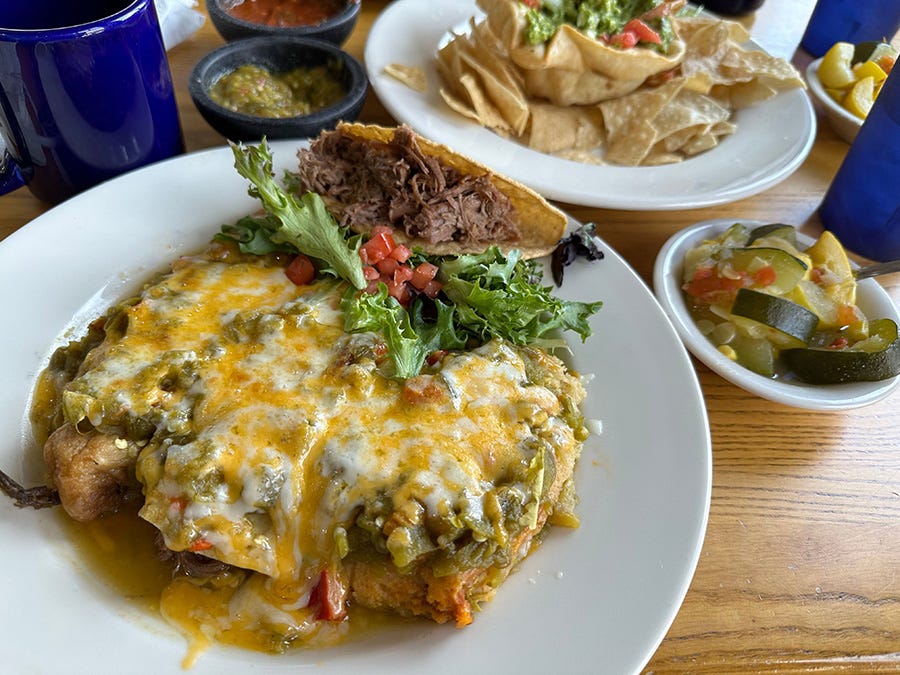
We took turns driving the seven hour route to Phoenix, traveling through the New Mexico and Arizona steppe along I-40 to Flagstaff before turning south on I-17 to descend from the Cococino Forest into the Sonoran Desert and Salt River Valley. The varying ecosystems and topography over this stretch of road is really fascinating to experience. The natural beauty of rock formations and lush forests juxtaposed with the relentless barrenness of the arid desert inspires a kind of awe that I didn’t truly appreciate as a youngster, riding alongside my dad on my many childhood visits to the southwest.
Indulging my curiosity and nostalgia, we temporarily bypassed Phoenix with sights set on Fountain Hills, a suburb to the northeast where my father lived for nearly a decade. I flew out from Ohio for a month every summer and every other Christmas from ages 6-13, so I feel a pretty strong connection to the place. A lot has changed in 30 years: only the namesake fountain4 and surrounding park felt familiar to me. The giant empty lots across Saguaro Boulevard have been completely filled up with retail development. Gaudy, bougie snowbird estate homes crawl further and further up the mountain sides. Corrupt former sheriff, convicted criminal and open racist Joe Arpaio was in the midst of a dirty campaign for mayor at the time of my visit, thankfully finishing in a distant third place since then. I feel pretty confident that this is the last time I’ll ever set foot in Fountain Hills. Frankly, I’m glad that chapter of my life can just be over.
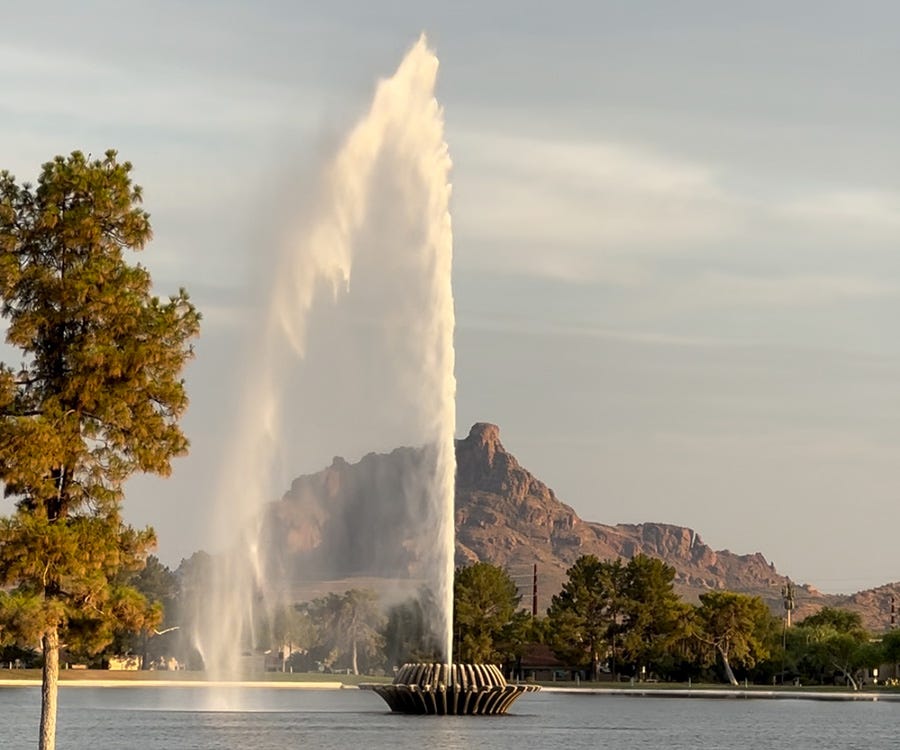
After a full day of sniffles and sore throat, I began to realize that this illness was showing all the telltale signs of COVID. The previous three times that I caught it, I never experienced any symptoms worse than a bad cold: no body aches, no chills, no fatigue and, most importantly, no shortness of breath. I’ve also been vaccinated at every opportunity and was prescribed Paxlovid to knock back viral growth. A rapid test confirmed my suspicions, so I got to work making adjustments to my schedule and looking into treatment options. That started with canceling my plans to go to the Arizona Diamondbacks game that night and looking into when I’d be able to reschedule.5 I also needed to acknowledge that the next night’s game in San Diego would also be in jeopardy, as would the Angels game in Anaheim we planned to attend the day after that.
As far as treatment was concerned, I was unable to get a virtual visit with my primary care doctor scheduled for a Paxlovid prescription, plus I had a slightly abnormal result on my most recent bloodwork that might have disqualified me for a prescription anyway, so I decided to just tough it out with some sinus medicine. Apart from the mild symptoms, I felt fine, good enough even to record a phone-in podcast appearance with my friends Rob and Andrew of the Arizona Craft Brewers Guild. As a public service, I spent the rest of the day in the hotel, using the time to write up our experience with the Texas Rangers.
Scott was still feeling fine so he went to the game, which turned out to be a 17-0 drubbing with the hometown Diamondbacks prevailing over the hapless Washington Nationals.6 The next morning, he offered to drive us to San Diego to give me some time to rest up in hopes we could still go to the Padres game that evening and use the $45 standing room tickets I had purchased a few days earlier before I knew sickness was about to beset us.
On the advice of my unofficial doctor,7 I masked up and went about my business in sunny San Diego. Scott splurged on a hotel in the Gaslamp Quarter adjacent to Petco Park, so we walked the three blocks to the park about a half hour before game time. Normally I like to get to the park at least an hour or so before first pitch, but considering that we had standing room tickets ostensibly meant for the Gallagher Square pavilion behind the center field fence, I figured we’d be on the move most of the night anyway and could get our lap in just trying to find spots to post up and watch the game.
Much like Camden Yards in Baltimore, Petco Park incorporated an existing building into its design. The southeast corner of the Western Metal Supply Company building serves as the left field foul pole, with the team offices and a few luxury suites built in to take in the game. We lucked out, finding a small outcropping between the building and the left field 200 level where we could lean on a rail and watch the game unfold. You won’t find it on the seating chart, but this little nook proved to be an ideal spot to watch the Dodgers-Padres tilt, at least until one of us would have to go to the bathroom and someone else would swoop in to take it.
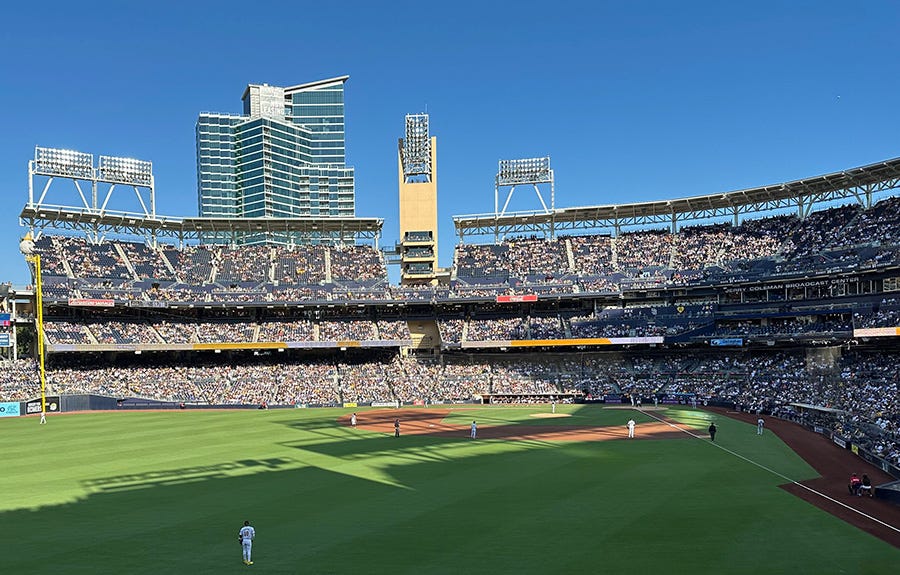
We stayed at our perch until the fifth inning, by which time the Padres had built up a safe 7-1 lead over the visiting Dodgers. Los Angeles starting pitcher Clayton Kershaw, who will be a first ballot hall-of-famer when eligible, was lit up by the Padres offense and let down by the Dodger defense, including a botched fielding attempt by Kershaw himself which eventually led to three unearned San Diego runs. Even without the three defensive miscues, the Padres were making solid and frequent contact, including a Luis Campusano homer that landed in the Western Metal Supply boxes about 50 feet from where we were standing.
Wandering around the plaza behind center field and through the concourses, I couldn’t help but be impressed by Petco Park. Food options were plentiful and unique, including many Padres-themed items and representative local businesses. The beer selection was excellent as well, in keeping with San Diego’s reputation as one of America’s finest craft beer cities. I enjoyed a .394 Pale Ale from Alesmith Brewing, named for Padres legend Tony Gwynn’s batting average in 1994, the closest any National or American League player has come to hitting .400 in a season since Ted Williams hit .406 in 1941.8 As I didn’t want to unmask for most of the game, I limited myself to just the one beer, but heartened by the knowledge that I could enjoy any number of excellent brews at the game, albeit at about $20 a pop.
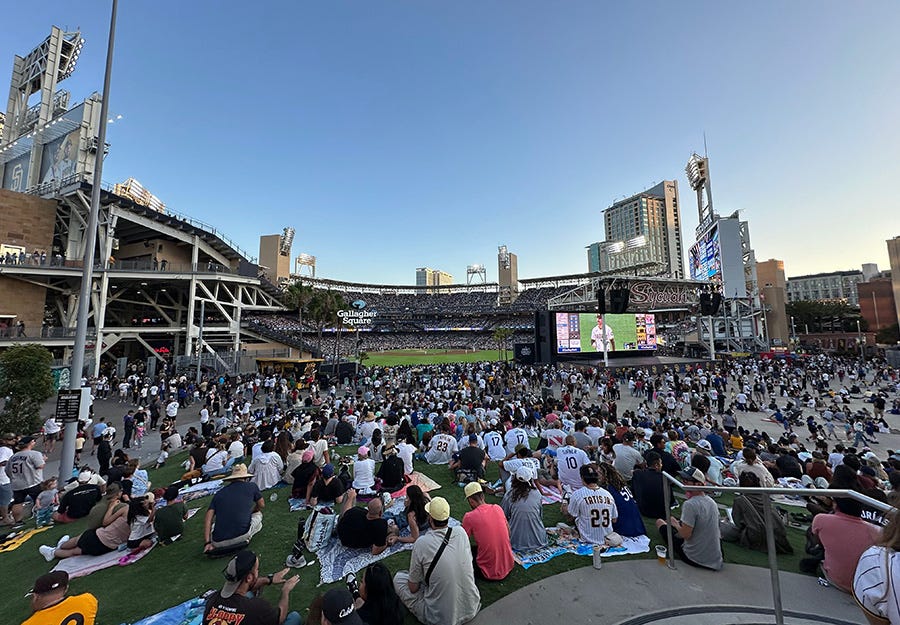
After the game, an eventual 8-1 Padres victory,9 we made our way back through the Gaslamp Quarter to the hotel for a much needed night of sleep. Our schedule was such that San Diego was going to get short shrift anyway, being bookended with games in Phoenix and Anaheim, but coupled with Scott and I both coming down with COVID — he began to feel a little wonky shortly after we arrived — we really didn’t get to take in as much of the city as we would’ve liked. Luckily, San Diego isn’t going anywhere, barring a catastrophic earthquake or rogue weapon of mass destruction, so I’ll just have to promise to make my way back sometime soon.
Two and a half weeks in November, shortly after I had wrapped up my stressful and time-consuming work on the merchandising and fundraising supply side of the Obama campaign. I guess there’s precedent for me abandoning my responsibilities and hitting the road for a long stretch to clear my head.
This episode, while in the show’s decline period and released to mixed reviews from critics, is credited for popularizing the words “meh” and “hungy” — short for “hungry” — in the American lexicon. Just more proof that even mediocre art can have lasting and profound impact.
Cleveland, Cincinnati and Seattle came close.
When completed in 1970, it was the tallest fountain in the world and held that title until the early ‘80s.
I’ll be back in Phoenix on Monday, August 12 to catch the Diamondbacks against the Colorado Rockies.
This one won’t count toward the Bleachers and ‘Bleeds home vs. away record because, well, I didn’t go to the game.
Six players in the Negro Leagues topped .400 from 1941-1948: Lyman Bostock Sr., Josh Gibson, Tetelo Vargas, Jesse Douglas, Artie Wilson and Willard “Home Run” Brown.
Home teams now 9-12 on the Bleachers and ‘Bleeds tour.



Typhoid Justin doesn't quite have the right ring to it. Glad you and Scott both recovered quickly